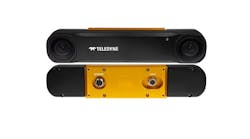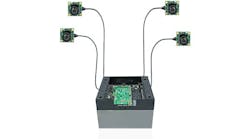Like a visit to the dentist, a visit to the doctor can be equally as painful, especially if you eat eggs and bacon for breakfast and are a little overweight. Knowing this, I was already prepared for the advice that my physician gave me when I visited her last month. I was told to go on a diet and exercise.
If you know me, you will understand the former is simply out of the question. However, I did attempt the latter one night last month when I decided to take my sad sorry bones for a walk in the park.
After having walked half a mile, I heard a strange buzzing noise emerging from the heavens and, yards ahead, saw a man holding a remote control unit. Looking 300ft upward, I spied an Inspire drone built by DJI (Shenzhen, China; www.dji.com). David Vogt (www.davidvogt.net), a professional photographer and operator was there to take aerial photographs of the village where I live.
As we looked at the perfect pictures of other peoples properties streaming to the screen of the iPad-based control unit from the drone’s on-board 12.4M pixel Sony Exmor-based CMOS camera, I wondered about the implications of such devices.
What if the folk below did not want people to take pictures of their houses? What if the drone crashed into an aircraft or an amateur pilot? What if rather embarrassing images of someone sunbathing suddenly appeared on the internet?
To date, the Federal Aviation Administration (FAA) has issued “guidelines” for the operation of such unmanned aircraft systems (UASs) that relate more to the operation of model aircraft. These include operating them at below 400ft, five miles away from airports and “away” from people. At present, the recreational use of such systems does not require permission from the FAA but if they are used to take images for profit, approval from the FAA must be obtained. However, drones such as the Inspire are already capable of maximum flight altitudes far above the 400ft “guideline” set by the FAA.
To date, a number of companies have applied for approval to operate UASs for videography, photogrammetry, map generation and home inspection applications under Section 333 of the FAA Modernization and Reform Act of 2012 (FMRA; http://1.usa.gov/1CLXJLN), a means designed to discouraging illegal operation and improve the safety of such systems.
While many companies will leverage low-cost drones such as the $3,500 Inspire, the demand fueled by hobbyists will lead to even lower cost devices that may not be used as responsibly. Indeed, drones have already been involved a number of potentially fatal accidents. In September last year, for example, a man was arrested after a police helicopter just avoided crashing into a drone in Brooklyn, New York. Then, in December, a passenger aircraft nearly collided with one as it landed at London’s Heathrow airport.
Needless to say, the current guidelines set out by the FAA will not be enough. Unfortunately for the FAA, developing a new set of rules for such systems will not be a walk in the park.
[email protected]







